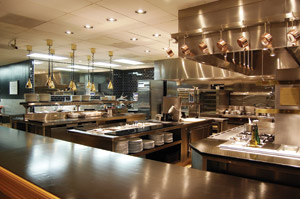Although it is now adjacent to The Grand Del Mar, a AAA Five Diamond luxury resort in San Diego, Addison was launched as a stand-alone restaurant a year prior to the resort opening.
 Addison’s 1,762-square-foot back of house is characterized by a custom cooking suite and dual central islands for both hot and cold food."Addison was built in 2006 in conjunction with a new clubhouse for the pre-existing championship golf course, and the hotel opened a year later," says Chef William Bradley, who helped design the kitchen and worked with the interior designer, Warren Sheets, on the finishing touches, such as china and tabletop décor. "We really helped launch the resort."
Addison’s 1,762-square-foot back of house is characterized by a custom cooking suite and dual central islands for both hot and cold food."Addison was built in 2006 in conjunction with a new clubhouse for the pre-existing championship golf course, and the hotel opened a year later," says Chef William Bradley, who helped design the kitchen and worked with the interior designer, Warren Sheets, on the finishing touches, such as china and tabletop décor. "We really helped launch the resort."
The restaurant is named after Addison Mizner, who is best known for launching Florida's renaissance design in the 1920s, featured in a number of Palm Beach and Boca Raton resorts. This motif inspired the architecture and design of The Grand Del Mar.
In addition to Addison, which serves contemporary French cuisine for dinner Tuesday through Saturday, the resort includes Amaya, a restaurant offering upscale cuisine all day; Club M, a casual restaurant, sports bar and nightclub that provides live music and dancing; a poolside eatery;
Cent' Anni, a gourmet shop providing hot beverages and pastries; and a lobby lounge with cocktails and live entertainment.
FE&S: Describe Addison's ambiance and décor.
WB: The almost 10,000-square-foot restaurant has the appearance of an Old World European restaurant. Although it's a tremendous space, it has an intimate feeling. The main dining room seats 80; the private dining room accommodates up to 50, and the chef's table seats up to 12 in a separate room with television monitors that look into the kitchen. Addison's décor includes Venetian-plastered walls in yellow hues; a gold and burgundy color palette; elaborate stone flooring; arches with carved stone columns; oversize decorative wrought-iron light fixtures; four limestone fireplaces; and detailed ceilings of varying heights. Doorways are trimmed with 22-karat gold accents, and marble flooring includes inlaid limestone. With a limestone fireplace imported from Italy, the main dining area showcases floor-to-ceiling windows and a vaulted wood-beam ceiling finished in a Bordeaux-glazed finish. The library lounge area includes a 13-foot-high carved limestone fireplace, while the adjacent Le Salon Bar and Lounge is centered around a handcrafted wood bar topped with solid stone. A 2,500-bottle wine room clad in Jerusalem limestone and trimmed in carved Italian stone features a triple arch with glass windows, providing views of the dining room and the resort's wine collection. Despite the elegant décor, the tabletop is refined and simple, which provides a good balance. It is stark with just a charger, bread plate and votive. Utensils are added as customers are serviced.
FE&S: What are the most popular and signature menu items?
WB: We don't have signature dishes. The menu is based on honoring and respecting the craft of cooking through understanding ingredients and how they work. Menu highlights include entrées with intense flavors and simple ingredients, such as baby sea scallops with watercress, avocado and golden caviar; ris de veau panés with caramelized onions, parmesan and arugula spring lamb; and persillé with toasted pistachio purée, dates and sauce chèvre. Coddled farm egg served with escargot, parmesan fondue and parsley is popular, as is poached Alaskan king crab. Summer is particularly exciting due to the variety of ingredients available in the area. Although the menu is seasonal, the dishes, presentation and flavor profiles can change daily, depending on the quality of what is available. So our offerings are driven by both Mother Nature and our purveyors. Prix-fixe menus, ranging from 3 to 7 courses, are available, in addition to a cart featuring 10 cheeses from California, Wisconsin, Italy and France.
FE&S: How would you classify your cuisine?
WB: My repertoire is French food, which is rooted in tradition. However, since we are located in Southern California, we modify the French cooking technique for health benefits. Instead of using a lot of butter and cream to emulsify the sauce, we fold in a vegetable purée and use more reductions. Our cooking techniques have changed with the times and are health conscious. This includes more poaching, baking, slow cooking and grilling than in the past.
FE&S: How is the back of house configured?
WB: I designed the kitchen layout in a brigade style based on the French system. The 1,762-square-foot space is characterized by a custom cooking suite and dual central islands for both hot and cold food. This includes a combi oven, which is used for braising, steaming and roasting, with refrigeration underneath. We also have a flattop, salamander and grill. A walk-in refrigerator is used to store our ingredients. The majority of production is accomplished with basic equipment, including blenders, mixers and ice cream and sorbet machines.
FE&S: What attributes do you look for in foodservice equipment?
WB: The main attributes I look for are versatility and durability. I like to buy the best to ensure quality. It's about buying the best tools for your craft. Energy efficiency also is important to us, and we utilize Energy Star-rated equipment. It's the sign of the times.



